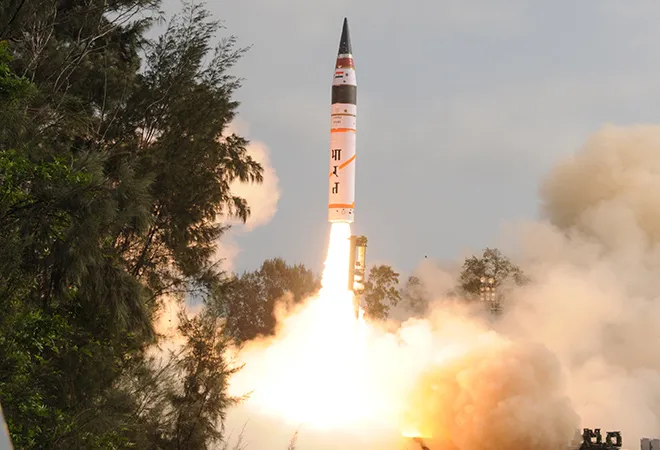
Counterspace technology is not a new phenomenon. In 1958, only one year after the successful launch of the erstwhile Soviet Union’s satellite, Sputnik 1—the first artificial satellite to ever complete an orbit around the Earth—the first nuclear tests in outer space were conducted. This was a cause for concern for the international community, which aimed to ensure that outer space did not become a new stage for warfare. And yet, despite this, counterspace capabilities remain an issue that has never been properly regulated. This regulatory gap nowadays presents a greater danger than ever: The more important space technology becomes to humankind—particularly for military purposes—the more eager states would be to protect their space assets. As such, in recent years, some states have been increasingly investing in the development and testing of anti-satellite weapons (ASATs), creating an escalatory cycle that threatens to pave the way towards the weaponisation of space, and eventually could lead to it becoming a theatre of conflict.
After the 1958 tests, the United Nations (UN) passed a resolution expressing the need “to avoid the extension of present national rivalries into this new field.” The growing concern also led to the creation of the Committee on the Peaceful Uses of Outer Space (COPUOS), and it was under its auspices that the 1967 Outer Space Treaty was eventually drafted, with a key objective of serving as an arms control treaty.
Despite this, the Outer Space Treaty does not actually provide much guidance on how to keep space secure. Only “plac in orbit around the Earth any objects carrying nuclear weapons or any other kinds of weapons of mass destruction, install such weapons on celestial bodies, or station such weapons in outer space in any other manner” (art. IV OST) is prohibited, which leaves states free to use conventional weapons in space as long as such weapons are not used aggressively against another space actor. As long as states comply with international law, including the UN Charter, they are essentially free to develop any defensive and offensive military capabilities they deem necessary to protect their national security interests in space.
Some states have been increasingly investing in the development and testing of anti-satellite weapons (ASATs), creating an escalatory cycle that threatens to pave the way towards the weaponisation of space, and eventually could lead to it becoming a theatre of conflict.
As such, the use of ASATs—as long as it is not directed against another actor— is considered legal. The international community nevertheless recognises the danger they pose. ASAT testing suggests that a state possesses the capabilities required for conducting attacks against others should it wish to do so. The demonstrated ability to target or compromise another state’s space technology has caused states to enact changes in their domestic space policies and strategies, raised tensions between adversaries and contributed to arms race dynamics.
The international community has made attempts to reduce those tensions and arrest the weaponisation of space. Emerging in 1978 during the 10th Special Session of the UN General Assembly on Disarmament, The Prevention of an Arms Race in Outer Space (PAROS), has been the primary objective of multilateral dialogue on space security, featuring regularly in UN resolutions and in the mandates of working groups.
Under PAROS, there have been several proposals to ban or to restrict the use of counterspace technology. Examples include the Sino-Russian draft Treaty on the Prevention of the Placement of Weapons in Outer Space (PPWT), first introduced in 2008 (and updated in 2014) and the EU International Code of Conduct for Outer Space Activities, also from 2008. However, none of these initiatives have managed to rally enough support to move forward. This is because of a fundamental disagreement between states on what the nature of a proposal to achieve the goals of PAROS should be. Certain states favour the enactment of a legally binding instrument while others prefer non-binding norms, and these methods have often been viewed as irreconcilable.
Yet the lack of consensus on solutions belies the emphasis states continue to put on addressing the issue: On 7 December 2020, the UN General Assembly passed Resolution 75/36 on “Reducing Space Threats Through Norms, Rules, and Principles of Responsible Behaviours.” This resolution encouraged states to “share their ideas on the further development and implementation of norms, rules, and principles of responsible behaviours and on the reduction of the risks of misunderstanding and miscalculations with respect to outer space.” A total of 30 States, the European Union, and nine non-state organisations (including UNIDIR) submitted their views, which were compiled in a report by the UN Secretary General. These submissions served to highlight a number of similarities in the concerns of many UN member states. Chief amongst these concerns is the testing and use of counterspace technologies, as they can cause severe physical damage to space assets through the creation of debris as well as interference. The reverberating effects of their use can also be significant: From the destruction or disruption of space objects, through kinetic or non-kinetic means, to the detriment of services they provide on Earth negatively impacting humanity.
The international community generally recognises the dangers of kinetic ASATs, but has shied away from condemning their use as illegal when done in the context of testing.
This bottom-up approach that allowed states to submit their views on space security served to pave the way to common understandings on space security matters, which could, in turn, de-escalate tensions and reduce the incentives for an arms race. However, whether the goals of this resolution will be achieved is yet to be seen. Could this be a step in the direction of finally achieving the goals of PAROS, and mark a shift away from the weaponisation of outer space? In theory, yes. The sharing of views on space security prompted by the resolution has highlighted that legally binding treaties and non-binding norms are not necessarily incompatible.
However, any regime—whether based on legally binding or non-binding mechanisms—is only as effective as states’ willingness to comply with it. While recent developments in the diplomatic sphere are encouraging, the hope for cooperation that they bring can easily be eclipsed by some states’ continued insistence on developing and testing ASATs. These actions endanger any progress made towards achieving the goals of PAROS.
Certain types of ASATs have been criticised to the extent that proposals for ASAT Test Guidelines have gained traction amongst states. The international community generally recognises the dangers of kinetic ASATs, but has shied away from condemning their use as illegal when done in the context of testing. In the face of this reluctance, several experts are urging the UN to consider a kinetic ASAT Test Ban Treaty. However, while such initiatives are commendable, on their own, they are insufficient to solve the problem. It is, therefore, imperative that states work to arrest their weaponisation of outer space, not only through diplomatic negotiations, but also through avoiding engaging in ASAT development and testing to foster de-escalation and prevent current tensions from blowing up into a full-blown conflict.
The views expressed above belong to the author(s). ORF research and analyses now available on Telegram! Click here to access our curated content — blogs, longforms and interviews.




 PREV
PREV


